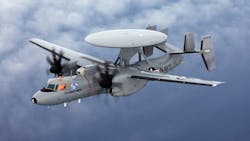Lockheed Martin to provide advanced airborne radar signal processing for Navy E-2D carrier-based aircraft
PATUXENT RIVER NAS, Md. – Airborne radar experts at Lockheed Martin Corp. will provide seven advanced radar signal processing retrofit systems for the U.S. Navy E-2D carrier-based radar early warning aircraft under terms of a $15.9 million order announced Wednesday.
Officials of the Naval Air Systems Command at Patuxent River Naval Air Station, Md., are asking the Lockheed Martin Rotary and Mission Systems segment in Liverpool, N.Y., to build seven retrofit advanced radar processor systems for the E-2D Advanced Hawkeye aircraft.
The Navy Northrop Grumman E-2D is a tactical airborne early warning (AEW) aircraft designed to operate from aircraft carriers. The twin-engine turboprop aircraft has a distinctive antenna, and provides the carrier battle group with wide-area radar surveillance for enemy monitoring and combat air traffic control.
The E-2D aircraft uses the Lockheed Martin AN/APY-9 radar for Navy carrier surveillance and theater air and missile defense missions. The AN/APY-9 provides the enhanced airborne command and control and expanded surveillance for the E-2D. The radar detects small maneuverable targets in difficult coastal-water and overland environments.
The AN/APY-9 radar for the E-2D surveillance aircraft features advanced radar signal processing subsystems to enable flexible radar beam management and enhanced target processing to help the radar pinpoint and track enemy aircraft and missiles, and reject clutter and radar interference.
The AN/APY-9 features mechanical and electronic scanning modes, providing the warfighter with 360-degree situational awareness around the aircraft, and the ability to augment mechanical scanning with electronic scanning to dedicate extra resources to challenging targets or 90-degree sectors in any direction.
The AN/APY-9 Radar detects air and sea surface targets simultaneously with its space-time adaptive processing (STAP) architecture, which suppresses clutter, jamming, and other sources of electromagnetic interference to focus on the target.
Related: U.S. Air Force scraps Boeing upgrade of AWACS radar digital signal processing subsystem
The AN/APY-9 operates at UHF which excels at long-range detection of difficult-to-find targets. High-power solid-state transmitter electronics increases reliability and sensitivity.
The radar has a high-reliability solid-state transmitter design, digital receivers, and exciter for waveform flexibility, low noise, and increased sensitivity. Its open-systems-architecture processor supports continuous technology insertion, and its circuit card computer hardware architecture simplifies system maintenance.
On this order Lockheed Martin will do the work in Liverpool, N.Y., and in Andover, Mass., and should be finished by February 2026. For more information contact Lockheed Martin Rotary and Mission Systems online at www.lockheedmartin.com, or Naval Air Systems Command at www.navair.navy.mil.

John Keller | Editor-in-Chief
John Keller is the Editor-in-Chief, Military & Aerospace Electronics Magazine--provides extensive coverage and analysis of enabling electronics and optoelectronic technologies in military, space and commercial aviation applications. John has been a member of the Military & Aerospace Electronics staff since 1989 and chief editor since 1995.

